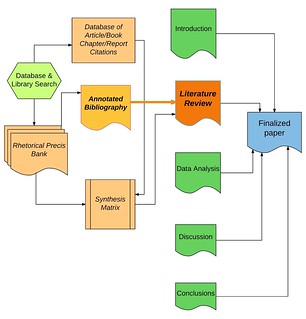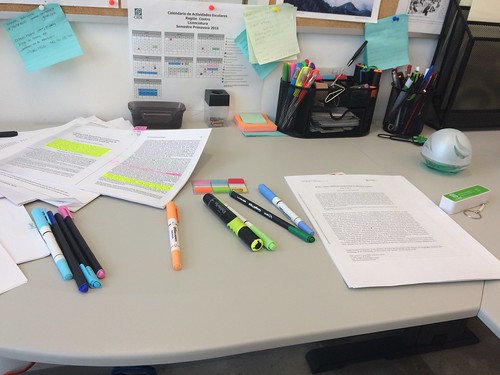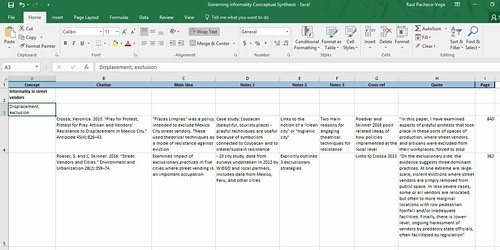I was recently asked by one of my current students to write about how to write a literature review.
@raulpacheco You should write about Literature Review. It would be so helpful for us!
— Manuel Cardona Arias (@ManiArias) January 25, 2017
I have finally written a sequential list of steps for how to do a literature review in 6 easy steps which you can check here. Admittedly, I have a full Resources sub-page for Literature Reviews.
Now that I have taken the time to write a full Protocol on how to go about the process (from selecting a topic to searching article databases to building the conceptual map for the literature review to actually writing it), in this post I want to highlight the differences between a conceptual synthetic table (my Excel dump, as I normally call it), an annotated bibliography, a bank of synthetic notes/rhetorical precis and a full-fledged literature review.
 I do want to emphasize the difference between a literature review, an annotated bibliography, and a conceptual synthesis, particularly because to me, all these can be scholarly outputs in and of itself, and all of them are intermediate steps between conducting a database search, writing a full literature review and completing an entire paper. The figure to the right shows what I consider are the main components of a traditional research paper. I am well aware that different people undertake research in various ways and that my model isn’t the gospel of truth. However, this is the way I have done it for a very long time (even before I did a graduate degree) and it makes a lot of sense to me.
I do want to emphasize the difference between a literature review, an annotated bibliography, and a conceptual synthesis, particularly because to me, all these can be scholarly outputs in and of itself, and all of them are intermediate steps between conducting a database search, writing a full literature review and completing an entire paper. The figure to the right shows what I consider are the main components of a traditional research paper. I am well aware that different people undertake research in various ways and that my model isn’t the gospel of truth. However, this is the way I have done it for a very long time (even before I did a graduate degree) and it makes a lot of sense to me.
Having a database of article and book chapter citations, a bank of rhetorical precis, an annotated bibliography and a literature review are all solid intermediate steps to writing a paper. What often happens (particularly because I’m not someone who can spend all this time generating the intermediate products) is that I create each one of these for a MACRO (larger) project, and then extract components for different papers.
For example, right now I’m conducting a literature review on street vendors and waste pickers. The first step I am taking in doing this review is to search databases for articles with specific keywords (this post of mine shows you how to do this citation tracing process until you reach conceptual saturation).
The second step I engage in is creating both a bank of rhetorical precis and an Excel worksheet (a database) of citations. You can create the database of citations simply by using Mendeley (or any other reference manager) and dumping all PDFs associated with a specific paper into a folder, as I do with my own papers. Mendeley can automatically generate a list of citations that can be exported as a .CSV
DO NOTE – this Excel worksheet or database of citations is NOT the same as my Conceptual Synthesis Excel Dump. The citation database is only a list, with basically no processing.
Both the database of article and book chapter citations and the bank of rhetorical precis are project products, but since they don’t involve analysis (nor synthesis), I don’t count them as scholarly outputs. I often ask my research assistants to build a bank of rhetorical precis with summaries of articles and book chapters I ask them to read and synthesize. I also build my own rhetorical precis’ databases as I often use them in conjunction with my Excel Conceptual Synthesis Dump.
From the figure I show here, you can see that creating the bank of rhetorical precis is often an intermediate step to building a Conceptual Synthesis Excel Dump. What differentiates a simple database of citations from a conceptual synthesis is that I extract quotations and sort papers by theme, as I’ve shown on this Conceptual Synthesis for a paper on informality.
Once I have the bank of rhetorical precis and my Conceptual Synthesis, I am well positioned to write either an annotated bibliography (which is an organized set of summaries of articles, books, book chapters that follow each paper’s citation). I normally go from rhetorical precis to annotated bibliography, but you can also draw from your extensive, in-depth memorandums. You can read an example of an annotated bibliography on transboundary water governance here, by Dr. Emma Norman and Dr. Karen Bakker from UBC’s Program on Water Governance.
From the annotated bibliography, once you start stringing together thematic syntheses of ideas and citations, you can build a conceptual mind-map of the literature, and start writing full paragraphs of the literature review. For example, this is a literature review on street vending in three countries (Thailand, Cambodia and Mongolia) published by the ILO.
Again, the difference between scholarly output and project product is that anything you generate during the course of a project can be a product, but what you’ve already processed and put intellectual thought on is a scholarly output.
Literature reviews, annotated bibliographies, and conceptual synthetic tables all are valuable scholarly outputs that can help our own research or that of other scholars, which is why it is important to be able to generate them and do them well. Hopefully my post will be of use to you when you write your own scholarly outputs!
ADDITIONAL RESOURCES ON HOW TO WRITE A LITERATURE REVIEW
- My own Resources sub-page on Literature Reviews.
- Dr. Inger Weiburn (The Thesis Whisperer) on 5 ways to tame the literature dragon.
- Dr. Tanya Golash-Boza (Get a Life, PhD) on 6 steps to a literature review.
- Dr. Pat Thomson on 5 ways to structure your literature review.
- Aurelie’s website “How to Do a Literature Review“.
- Dan’s website “Literature Review HeadQuarters“.
- University of Adelaide’s Writing Centre’s handout on how to write a literature review
- Dr. Marco Pautaso’s 10 steps to a literature review
- Florida International University’s Writing Services’ handout on literature reviews and conceptual matrices.
- Professor Mongan-Rallis’ steps to a literature review.



0 Responses
Stay in touch with the conversation, subscribe to the RSS feed for comments on this post.